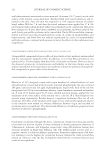J. Cosmet. Sci., 72, 173–188 (March/April 2021) 173 Next-Generation Natural Baby Barrier Cream Formulations: Physicochemical Analysis and Safety Assessment AHMET ARIF KURT, ISMAIL ASLAN, and GULENGUL DUMAN , Vocational School of Health Services, Suleyman Demirel University, Isparta 32040, Turkey (A.A.K.), Department of Pharmaceutical Technology, Hamidiye Faculty of Pharmacy, University of Health Sciences Turkey, Üsküdar, İstanbul 34668, Turkey (I .A.), SFA R&D Laboratories, Pendik, İstanbul 34906, Turkey (I. A.), Department of Pharmaceutical Technology, Faculty of Pharmacy, Yeditepe University, Ataşehir, Istanbul 34755, Turkey (G.D ) Accepted for publication December 15, 2020. Syno p sis The b ackground of this article is to develop formulations consisting of natural raw materials that are effective in diaper rash by taking advantage of the medicinal properties of zinc oxide, natural oils, and beeswax. The purpose of this research was to determine the appropriate amounts of the constituents of the formulation and to determine the optimum formulation by comparing the margin of safety (MoS), and microbiological and physicochemical properties of the best formulation. For this purpose, parameters such as pH, rheological behavior, hydrophilic and lipophilic balance (HLB), zeta potential, and polydispersity index were analyzed and evaluated to determine the optimum formulation. Besides, microbiological reproduction and 3-month stability studies of the developed product were carried out, and it has been proven that the developed product maintains both microbiological and stability properties throughout its shelf life. Furt hermore, whether each raw material used in the selected optimum formulation remained within MoS values was evaluated according to exposure doses in the literature. Whether it maintains the desired properties throughout the shelf life was evaluated by stability studies. In this article, eight different zinc oxide–based formulations for preventing diaper rash were developed, and their physicochemical properties were examined to optimize cream formulations. baby barrier cream (BBC)-8 was chosen as the ideal formula by comparing all the parameters obtained as a result of the analysis. As a result of the optimization studies of the BBC-8 formulation, the pH value was 7.2, the viscosity property was pseudoplastic-type fl ow, the particle size was 533.2 nm ± 6.93, and the zeta potential was -30.9 mV ± 0.72. The theoretical safety assessment of each constituent has been made according to the European Union Cosmetics Directives. According to the calculations made on each raw material in BBC-8 according to the directives, the MoS value was found to be more than 230. For the stability studies, no microbiological growth was observed at the end of the 3-month stability studies at 25 and 40°C. In terms of the development of future natural cosmetic product formulations and the defi nition of “natural formulation,” it gives hope to prepare a safer cosmetic product for baby rash creams that do not contain preservatives, perfumes, and dyes and consists of natural oils and zinc oxide. Address all correspondence to Ismail Aslan at eczismailaslan@gmail.com
JOURNAL OF COSMETIC SCIENCE 174 INTRODUC T ION AN OVERV IEW OF BABY SKIN AND DIAPER RASH Baby ski n consists of three layers anatomically from outside to inside these are epidermis, dermis, and hypodermis layers. It is surrounded by the outermost stratum corneum (SC) layer of the epidermis, which acts as a physical barrier and is the primary regulator of percutaneous absorption (1,2). Diaper rash is probably one of the most common skin problems in infancy and early childhood observed as a rash on the skin. The prevalence of diaper rash varies signifi cantly in different parts of the world, and its incidence is between 15 and 50% (3,4,5). Besides, in terms of the diaper rash rate, it is observed that smooth severity while moderate is 4% and seriously monitored as 2% (6). There are several envi- ronmental factors causing diaper rashes such as wetness, pH, fecal enzymes, diaper type, diaper replacement frequency, diet, and oral antibiotic use. The skin becomes more sensi- tive because of environmental factors and contribution of mechanical factors, and the barrier function of the SC may deteriorate and foreign substances may easily penetrate the epidermal layers. According to the European Union “Test Guideline for the Safety Assessment of Cosmetic Ingredients,” whereas the adult margin of safety (MoS) value must be more than 100, the MoS values of newborn babies must be more than 230 for each ingredient (7). BABY BAR RIER CREAM (BBC) FORMULATIONS AND NATURAL INGREDIENTS The BBCs protect the lipid layer on the skin in babies against irritating factors and harm- ful microorganisms. Some topical BBC formulations contain natural ingredients such as olive oil, beeswax, zinc oxide, and lanolin, and they possess many preventive and regen- erative benefi cial properties in the rash (8). Prophylactic and therapeutic non-pharmaco- logical methods for the prevention of rash are defi ned by the ABCDE code: air, barrier cream, cleaning, diaper, and education (3,8). ZINC OXI DE Zinc oxi de is widely used in BBCs to prevent diaper rash it reduces the contact of baby skin with irritant factors such as urine and feces, repairs the SC, and prevents exposure to wetness. Thus, it contributes to the preservation of the skin’s natural structure, creates a lipid barrier, and prevents the infection problem (9,10). Topically applied zinc oxide is typically inert and biocompatible for the skin. Zinc oxide does not irritate normal skin between pH 6–7 when combining with other natural ingredients in baby rash barrier cream formulations. Systemic exposure has always been an important issue as a result of topical use of zinc oxide. Zinc oxide particles are nontoxic and do not penetrate normal or damaged human skin, and there is no poison risk to human health (11). Besides, some studies show that natural approaches such as beeswax and olive oil are also effective in preventing diaper rash (12). BEESWAX Beeswax is a natural raw material that has hydrophobic properties against wetness and maintains the moisture of the skin thanks to its good covering properties. Depending on
Purchased for the exclusive use of nofirst nolast (unknown) From: SCC Media Library & Resource Center (library.scconline.org)

























































































































